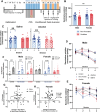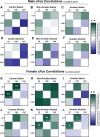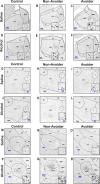This is a preprint.
Stressed Avoider rats show blunted sensitivity to alcohol's aversive effects: Potential contributions of the lateral habenula and lateral hypothalamus
- PMID: 40501960
- PMCID: PMC12154942
- DOI: 10.1101/2025.05.23.655819
Stressed Avoider rats show blunted sensitivity to alcohol's aversive effects: Potential contributions of the lateral habenula and lateral hypothalamus
Abstract
Avoidance coping following stress exposure predicts heightened alcohol drinking. Similarly, blunted sensitivity to the aversive effects of alcohol facilitates increased drinking. However, the relationship between stress exposure, coping mechanism, and sensitivity to alcohol's aversive effects is unknown. In rats, predator odor stress increases alcohol intake in animals that show persistent avoidance of stress-paired stimuli, termed "Avoiders". Here, we tested the hypothesis that Avoider rats have blunted sensitivity to alcohol's aversive effects using an alcohol-induced conditioned taste aversion (CTA) paradigm. After a single conditioning session, Non-Avoider rats acquired alcohol-induced CTA while Avoiders did not. Male rats across all groups eventually acquired alcohol CTA after four conditioning sessions. However, in females, only Non-Avoiders acquired alcohol-induced CTA. In male Non-Avoider rats, a single CTA-inducing dose of alcohol increased cFos expression in the lateral habenula (LHb), an important nucleus in aversion signaling. In male Avoiders, the same dose of alcohol decreased LHb cFos expression. cFos expression in the lateral hypothalamus (LH), which provides glutamatergic inputs to the LHb, was also diminished by alcohol in male Avoider rats. In females, alcohol had no effect on cFos cell counts in the LHb. However, in the LH, alcohol diminished cFos expression in female Non-Avoiders. Collectively, these findings suggest that stressed Avoider rats are hyposensitive to alcohol's aversive effects, which may facilitate their heightened alcohol drinking after stress. Sex- and stress group-specific differences in LH and LHb recruitment highlight these regions as candidates for mediating stress-induced changes in alcohol behaviors.
Keywords: alcohol; aversion; avoidance; central amygdala; lateral habenula; lateral hypothalamus; predator odor.
Conflict of interest statement
Declaration of Interests The authors declare they have no conflict of interest.
Figures






Similar articles
-
Role for the Rostromedial Tegmental Nucleus in Signaling the Aversive Properties of Alcohol.Alcohol Clin Exp Res. 2016 Aug;40(8):1651-61. doi: 10.1111/acer.13140. Epub 2016 Jul 8. Alcohol Clin Exp Res. 2016. PMID: 27388762 Free PMC article.
-
The lateral habenula is not required for ethanol dependence-induced escalation of drinking.Neuropsychopharmacology. 2022 Nov;47(12):2123-2131. doi: 10.1038/s41386-022-01357-7. Epub 2022 Jun 18. Neuropsychopharmacology. 2022. PMID: 35717465 Free PMC article.
-
Signs and symptoms to determine if a patient presenting in primary care or hospital outpatient settings has COVID-19.Cochrane Database Syst Rev. 2022 May 20;5(5):CD013665. doi: 10.1002/14651858.CD013665.pub3. Cochrane Database Syst Rev. 2022. PMID: 35593186 Free PMC article.
-
Intravenous magnesium sulphate and sotalol for prevention of atrial fibrillation after coronary artery bypass surgery: a systematic review and economic evaluation.Health Technol Assess. 2008 Jun;12(28):iii-iv, ix-95. doi: 10.3310/hta12280. Health Technol Assess. 2008. PMID: 18547499
-
Selenium for preventing cancer.Cochrane Database Syst Rev. 2018 Jan 29;1(1):CD005195. doi: 10.1002/14651858.CD005195.pub4. Cochrane Database Syst Rev. 2018. PMID: 29376219 Free PMC article.
References
-
- Alcohol-Related Disease Impact | CDC. (n.d.). Retrieved May 20, 2025, from https://nccd.cdc.gov/DPH_ARDI/default/Default.aspx
Publication types
Grants and funding
LinkOut - more resources
Full Text Sources
